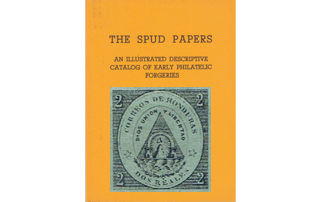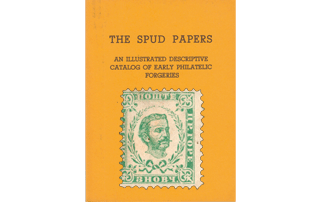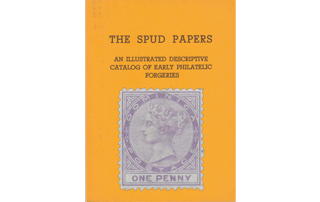 1872. 2 Sen, Vermilion.
1872. 2 Sen, Vermilion.
I would caution our readers against the forgery of this stamp, as it is very likely to mislead, and the forgers have been unusually successful with it.
Genuine
Engraved in taille-douce, on very yellowish laid pelure paper; perf. 11. There are many differences between this stamp and its counterfeits, but it is a matter of very great difficulty to describe them,—as anyone may see for himself, who will take both, and lay them side by side and compare them. The ink stands out very well from the paper, and the different parts of the design are not blotched in any part, except that the outer line of the frame sometimes runs into the next line, forming one thick line instead of two thin ones. As this line is seldom blotched all the way round, it will be seen that there are three lines forming the outer border of the stamp. There are seven lozenge-shaped ornaments running across the stamp, both above and below the dragons, inside the Etruscan bordering, and parallel with it. The tongue of the left-hand dragon touches the lozenge immediately above it, but the tongue of the right-hand dragon does not.
Forged
Lithographed, on whitish wove pelure paper; pin-pricked 13. The ink does not stand out from the paper at all, and the design is blotched in many parts. There are only two lines forming the outer border, a thick one and a thin one. There are seven-and-a-half lozenges running across the top of the stamp inside the Etruscan border. The lozenges at the bottom are like the genuine, except that the last on the left is smaller than the rest. The tongues
of both dragons touch the lozenges above them. The best tests for these forgeries are the wove paper, and the small pin-pricked perforations, instead of the unmistakably laid paper and large machine-perforations of the genuine.
Postmarks
All my own used copies are postmarked with a square, enclosing some Japanese characters, struck in blue. The forgeries have three varieties of postmarks on the one sheet: a large, solid, five-pointed star, a single-lined circle containing NAGASAKI, and a black, circular patch, divided into four quarters, and the quarters so far removed from each other as to leave a white cross in the center. I am sorry that I cannot give a fuller description than the above of this forgery, but the design is so very complicated that I should only confuse, instead of enlightening the reader.
 1873. 2 Sen, Yellow.
1873. 2 Sen, Yellow.
Genuine
Engraved in taille-douce; perf. 11 x 11 1/2. The perforations at top and bottom are large, clean-cut, and close together, whilst those at the sides are small, not very cleanly pierced, and far apart, like the British Guiana perforations. There are no fewer than forty types of this stamp, and our readers may suppose that it was no easy task to discover which of the forty was the type selected by the forgers for imitation. There are four value-labels, and the outlines of each are perfectly parallel with the outlines of the frames which contain the said labels. The figure 2 in the bottom label is somewhat shorter than the letters of the word SEN. There is a very small transverse open oval at the end of each of the spokes of the wheel-like flower at the top of the central portion of the stamp; and where the spokes converge, they do not run into each other. The flowers in the right-hand branch have nine petals, tolerably distinct, and the lower ends of the branches are on a level with the center of the small square label which is fastened just where they cross. (In some types this label is absent, but all the forgeries have it.) The flowers in the left-hand branch are bells.
Forged
Lithographed; perf. 13, and gummed. These are the first gummed productions of our friends from Hamburg which I have had the pleasure of dissecting; and they have overdone their imitation; for, although there is little gum on the forgeries, there is much less on the originals. The outlines of the value-labels are not by any means parallel with the outlines of the frames which contain them. The two outlines almost touch each other in the lower right-hand portion of each of the upright labels; and under the figure 2 of SEN, both at top and bottom, they are too far apart. The figure 2 in the bottom label is much higher than the letters of the word SEN. There are no open ovals at the outer ends of the spokes of the wheel; and the spokes are blotched, and run together where they converge in the center. The center is more oval than circular. The only flower in the right-hand branch whose petals can be counted, has eight instead of nine. The lower end of the right-hand branch, which is crossed over on to the left of the stamp, comes down as far as the bottom of the little square label. The flowers in the left-hand branch look more like buds (flower-buds) than anything else. The ink on the genuine stamps stands out well from the face of the stamps, whilst it is perfectly flat and smooth in the forgeries.
Postmarks
The usual postmark is what heralds would call a “cross voided”. It is formed of four V’s, or rather right angles, placed point to point, but not touching, being about 1/4 of an inch apart. I have found, occasionally, a round blotch, like the one which sometimes disfigures the last United States issue. The forgeries are postmarked with a large oblong of small square dots.
 1873. 30 Sen, Grey.
1873. 30 Sen, Grey.
Genuine
Engraved in taille-douce, on thick, soft, yellowish-white wove paper, machine perforated 13. The forgery is imitated from the edition which bears the plate letter like our figure 1 in the little oval where the stems of the branches cross; and, therefore, I will describe from the genuine one which bears that letter or figure, or syllabic character. The oblique side-stroke of the said plate letter almost touches the left side of the oval which contains it. The top leaf of the right-hand wreath, and the top leaf but one of the left-hand wreath, just touch the chrysanthemum, or wheel-like flower at the top of the central rectangle. The lowest hieroglyphic of the column of Japanese words in the center of the stamp almost touches the top of the little oval which contains the plate letter. The central tongue of the 3 in the top label is quite blunt, and projects almost level with the top and bottom curls of the figure; the same is the case with the 3 in the lower label. The inscription, both at top and bottom, reads 30SEN; i.e., there is no proper division between the numerals and the word. The bottom of the stalk of the left-hand branch just touches the lower spiral of the bell ornament in the right-hand bottom corner on the inner rectangle; and the bottom of the stalk of the right-hand branch is at some little distance from the similar spiral of the bell ornament in the left-hand bottom corner of the inner rectangle. The dot outside each of the bell ornaments is placed exactly at the apex of the bell. The bell in the right-hand top corner has 14 lines of shading in the narrow part, and 17 lines, and a fringe of 16 dots, in the wide part. The bell in the left-hand top corner has 16 lines in the narrow part, and 17 lines and 16 dots in the wide part. The bell in the bottom right-hand corner has 15 lines in the narrow part, and 17 lines and 13 dots in the wide part. The bell in the bottom left- hand corner has 13 lines in the narrow part, and 13 lines and 15 dots in the wide part. The most usual postmarks are either a thing like a five-armed star-fish—which is, I believe, the Japanese for “Post”—or a large blotch, or a St. Andrew’s cross in red, apparently laid on with a brush.
Forged
Lithographed on paper closely resembling that of the genuine, in almost exactly the same shade of colour, pin-perforated 13 1/2. The oblique side-stroke of the plate letter is very short, and does not come near the left side of the containing oval. Neither of the branches touches the wheel-flower. The lowest Japanese character in the central rectangle does not go near the top of the oval below it. The central tongue of the upper 3 ends in a sharp point, and is very short, so that it is not nearly level with the top and bottom curls of the said numeral. The lower 3 is just like the upper one. There is a slight division between 30 SEN, more plainly to be seen in the top inscription than in the bottom one. The bottom end of the right-hand branch touches the spiral curl of the left-hand bell ornament, and the bottom end of the left-hand branch is at some distance from the spiral curl of the right-hand bell ornament. The dot outside the top right-hand bell is too much to the left, the dot above the top left-hand bell is too much to the right; the dots below the bottom bells are about in their right places. The top right-hand bell has 11 lines in the narrow part, and 12 lines and 10 dots in the wide part. The top left-hand bell has 12 lines in the narrow part, and fourteen lines in the wide part, but the dots fringing this latter bell are run together, so that they cannot be counted. The bottom right-hand bell has 18 lines in the narrow part, and 15 lines and 8 joined dots in the wide part. The bottom left-hand bell has 12 lines in the narrow part, and 13 lines and 11 dots in the wide part. Two different postmarks are used for these counterfeits; the one being an oval formed by 4 parallel straight lines at the top and bottom, and 5 curved lines each side; the other being a large rectangle of square dots.
 1875-76. 12 Sen, Rose.
1875-76. 12 Sen, Rose.
Genuine
Engraved on thickish white wove paper; perf. 13. How these stamps are engraved I am unable to say, but they have all the appearance of taille-douce impressions; so that they may be readily distinguished from the lithographed forgeries. Of all the set, this 12 sen is the most difficult to describe, as the chief differences consist of variations in the forms of the Japanese letters; and I cannot explain these verbally. The other tests are as follows; there are 16 rays to the chrysanthemum at the top of the stamp; the s of SEN is much smaller than the EN; the legs of the bird are not visible; and its beak points to the N of SEN.
Forged
Lithographed, on thinnish, yellowish wove paper, perf. 13. In these stamps the forged are almost as well perforated as the genuine. There are only 13 rays to the chrysanthemum, and they are not distinct like the genuine. The s of SEN is the same size as the other letters. The bird has very long legs; almost in the style of the grallatores, in fact; and this alone is a sufficient test. The beak of the said bird points to the E of SEN.
 1875-76. 15 Sen, Lilac.
1875-76. 15 Sen, Lilac.
Genuine
Engraved, as above; perf. 13. There are 16 rays to the chrysanthemum at the top. The two left-hand roses do not touch the outer line of the circle. The bird’s tail has the feathers almost parallel, and four toes can be counted on the foot. At the bottom of the circle, between 15 and SEN, is a small figure 1, which is, I suppose, the plate-number.
Forged
Lithographed, like forged 12 sen; perf. 13. There are 18 rays to the chrysanthemum, but they are very much blotched in most copies. The two left-hand roses distinctly touch the outer line of the circle. The bird’s tail is somewhat fan-shaped. There are only two toes visible on the bird’s foot. The plate-number is a sort of 4. The forgers have evidently mistaken the figure altogether; I suppose because the up-stroke of the 1 in the genuine stamps is rather too prominent.
 1875-76. 45 Sen, Red.
1875-76. 45 Sen, Red.
Genuine
Engraving, paper, and perforation, as above. It will be noticed there are sixteen rays in the chrysanthemum, which are even more distinct than in the other values. The roses in the top corners are the same size as those at the bottom. Below these roses, outside the circle, there are two fan-shaped ornaments; the right has ten rays, and the left one has eleven. The two leaves which point to the chrysanthemum do not touch it, though they come very near it. There are nine feathers in the tail of the bird; and it will be observed there is a large white patch under its throat. The eye is visible, though very small.
Forged
Lithographed as above. There are seventeen rays in the chrysanthemum, nine in the right-hand fan, and eight in the left. The two top roses are much smaller than the bottom ones. The two leaves touch the chrysanthemum on each side. There are only five feathers in the bird’s tail; there is no white patch under its throat, and moreover the eye is not visible.
Postmarks
The 12 sen, forged, is postmarked with a large circle, containing NAGASAKI in large black capitals. The 15 and 45 sen bear an imitation of our own postmark, without the central figures. I have not received any of this issue post-marked, so I do not know the genuine obliteration.
The genuine are backed with thick yellow gum; the forgeries are ungummed, in sheets of 25, 5 x 5 .
From “The Spud Papers” by Atless, Pemberton & Earée, 1871-1881.
 1870. 5, 10, 20, 25, 50 & 100 Reis.
1870. 5, 10, 20, 25, 50 & 100 Reis.









































